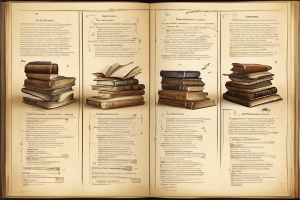Timeline of books:
Books, those magical repositories of knowledge and imagination, have been with us for millennia. Their evolution reflects the changing tides of human history, technology, and culture. Today, we embark on a journey through time, tracing the remarkable timeline of books, from ancient clay tablets to the e-readers of today.
1. Dawn of the Book: Cuneiform and Scrolls (3500 BC – 400 AD)
Our story begins in ancient Mesopotamia, where the earliest forms of writing emerged around 3500 BC. Cuneiform, a script pressed into clay tablets, recorded myths, laws, and administrative records.
Across the world, civilizations like Egypt developed papyrus scrolls, made from reeds woven together and inscribed with hieroglyphics, or hieratic script. These scrolls housed stories, religious texts, and government documents.
2. Bound Beginnings: The Codex and Parchment (2nd Century BC–14th Century AD)
Around the 2nd century BC, a new format emerged: the codex. Similar to modern books, codices consisted of bound pages made from parchment, a treated animal skin that was more durable than papyrus. This innovation paved the way for easier reading and organization and became the dominant format for centuries.
3. The Scribe’s Workshop: Hand Copying and Monasteries (5th Century–1450 AD)
Throughout the Middle Ages, books were painstakingly copied by hand by monks and scribes in monasteries. These beautiful manuscripts, often adorned with elaborate illustrations, preserved knowledge and religious texts across generations.
However, hand copying was a slow and expensive process, limiting the availability of books. This changed forever with the invention of the printing press…
4. Gutenberg’s Revolution: The Printing Press and Mass Production (1450–1800)
In 1440, Johannes Gutenberg in Germany revolutionized the world with his movable type printing press. Individual letters made of metal could be arranged and reused to print books much faster and cheaper than hand copying.
The Gutenberg Bible, printed in 1455, became a landmark achievement, ushering in the age of mass-produced books. Knowledge and literature became more accessible, fueling the Renaissance and the spread of new ideas.
5. Industrial Ink: The Rise of the Modern Book (1800–Present)
The Industrial Revolution further transformed book production. Papermaking machines, steam-powered presses, and cheaper materials like wood pulp made books even more affordable and widely available. The rise of novels, newspapers, and mass literacy transformed societies around the globe.
6. Digital Dawn: E-readers and the Information Age (2000–Present)
The 21st century has witnessed the digital revolution in books. E-readers like the Kindle offer vast libraries at your fingertips, changing the way we read and access information. Online publishing platforms and self-publishing empower new voices, democratising the book-creation process.
But as digital formats evolve, the allure of the physical book endures. Independent bookstores thrive, and collectors cherish the tactile experience of turning pages and the smell of old paper.
The course of events in books is a demonstration of human creativity and our hunger for information and stories. As innovation keeps on developing, one thing is sure: the force of books to illuminate, engage, and move will stay ageless.
This excursion through history is only a brief look into the intriguing universe of books. Every time holds its accounts and advancements, ready to be investigated. In this way, whether you favor the pop of old material or the smooth swipe of a tablet, remember that each book is an entry to a different universe, ready to be opened and gobbled up.

